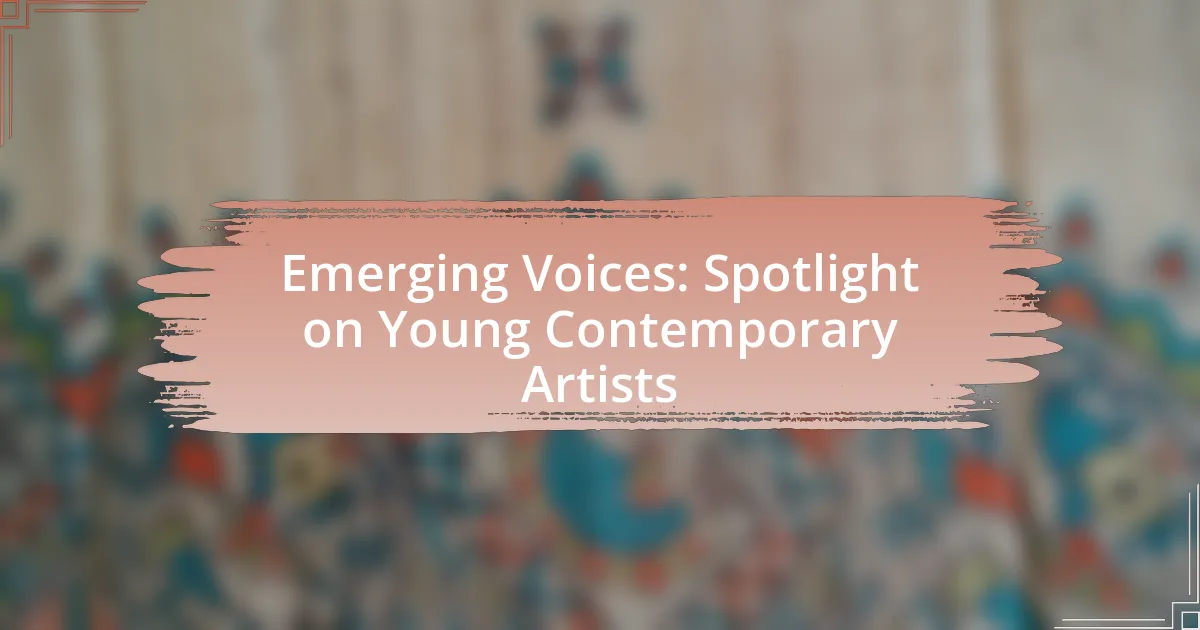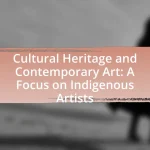Emerging voices in contemporary art are characterized by their innovative approaches and unique perspectives that challenge established norms. This article explores how young contemporary artists are identified, the criteria used to evaluate their work, and the impact of age on their artistic expression. It highlights the importance of spotlighting these artists, the common themes they address, and how social issues influence their art. Additionally, the article discusses the role of technology, popular mediums, and the significance of platforms for showcasing their work, as well as effective ways to engage with and support emerging artists in the art community.
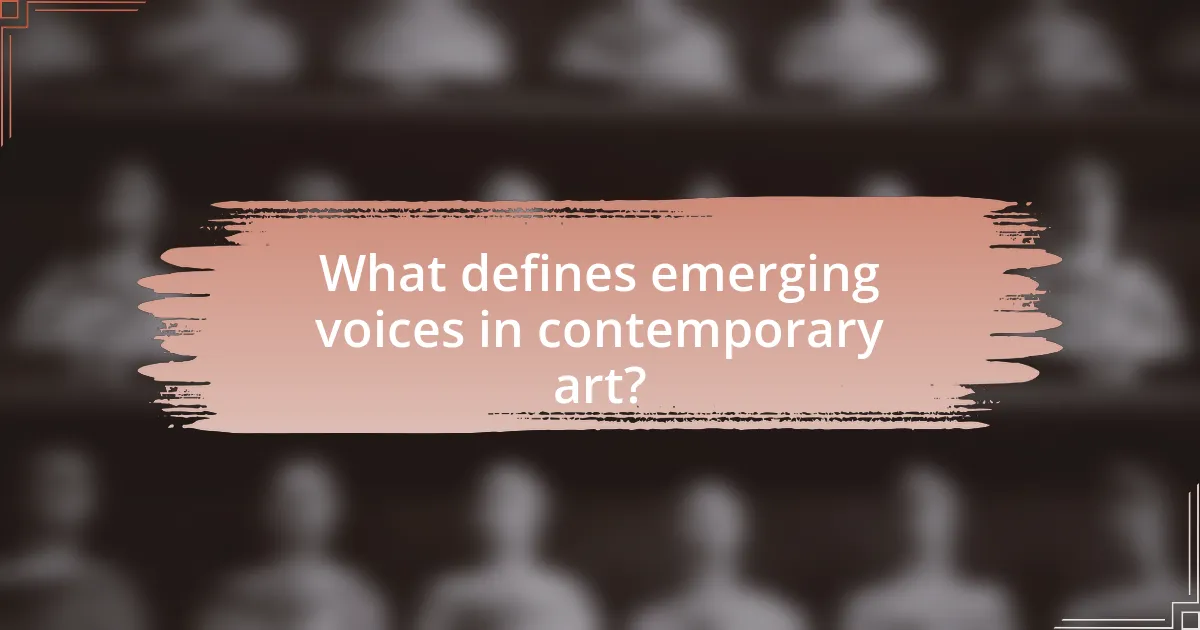
What defines emerging voices in contemporary art?
Emerging voices in contemporary art are defined by their innovative approaches, unique perspectives, and the ability to challenge established norms. These artists often utilize new mediums and technologies, reflecting current societal issues and personal narratives. For instance, many emerging artists engage with themes such as identity, globalization, and environmental concerns, which resonate with contemporary audiences. The rise of platforms like social media has also enabled these artists to reach wider audiences, facilitating their visibility and impact in the art world.
How do we identify young contemporary artists?
Young contemporary artists can be identified through their innovative approaches to art, participation in exhibitions, and engagement with current social issues. These artists often showcase their work in galleries, art fairs, and online platforms, making their presence known in the contemporary art scene. Additionally, they frequently utilize social media to connect with audiences and promote their art, which helps in recognizing emerging talent. Research indicates that platforms like Instagram have become vital for young artists to gain visibility and establish their careers, as evidenced by the rise of artists who have garnered significant followings and opportunities through these channels.
What criteria are used to evaluate their work?
The criteria used to evaluate the work of young contemporary artists include originality, technical skill, conceptual depth, and engagement with current social issues. Originality assesses the uniqueness of the artist’s vision and approach, while technical skill evaluates their proficiency in chosen mediums. Conceptual depth examines the ideas and themes presented in the artwork, and engagement with social issues reflects the artist’s ability to connect their work to contemporary societal conversations. These criteria are commonly referenced in art critiques and exhibitions, highlighting their importance in the evaluation process.
How does age influence artistic expression?
Age significantly influences artistic expression by shaping the themes, techniques, and perspectives artists explore. Younger artists often reflect contemporary issues, personal identity, and social change, utilizing modern mediums and technologies, as seen in the rise of digital art among millennials and Gen Z. Research indicates that artists in their twenties and thirties frequently engage with topics like climate change and social justice, which resonate with their generational experiences. In contrast, older artists may draw from historical contexts, personal narratives, and traditional techniques, often reflecting on life experiences and cultural heritage. This generational divide in artistic expression is evident in exhibitions and art movements, where younger artists challenge established norms and older artists preserve and reinterpret them.
Why is it important to spotlight young artists?
Spotlighting young artists is important because it fosters innovation and diversity in the arts. Young artists often bring fresh perspectives and unique experiences that challenge traditional norms, contributing to the evolution of artistic expression. For instance, a study by the National Endowment for the Arts found that exposure to diverse artistic voices enhances cultural understanding and community engagement. By promoting young talent, the art community not only supports the next generation of creators but also enriches the cultural landscape with new ideas and narratives.
What impact do emerging voices have on the art community?
Emerging voices significantly enrich the art community by introducing fresh perspectives and innovative ideas. These artists often challenge established norms and conventions, fostering diversity and inclusivity within the art world. For instance, the rise of social media platforms has enabled young artists to gain visibility and share their work globally, leading to a democratization of art access. According to a 2021 report by Art Basel and UBS, 63% of collectors are now more likely to purchase works from emerging artists, highlighting the growing recognition and support for new talent. This shift not only revitalizes artistic expression but also encourages dialogue around contemporary issues, making the art community more dynamic and relevant.
How do they challenge traditional art narratives?
Young contemporary artists challenge traditional art narratives by incorporating diverse perspectives and innovative mediums that reflect contemporary social issues. They often reject established artistic conventions, opting instead for interdisciplinary approaches that blend visual art with technology, performance, and community engagement. For instance, artists like Ai Weiwei and Kehinde Wiley utilize their platforms to address themes of identity, politics, and cultural heritage, thereby reshaping the discourse around what constitutes art. This shift is evidenced by the increasing prominence of street art and digital installations in major art institutions, which signifies a departure from the exclusivity of traditional galleries.
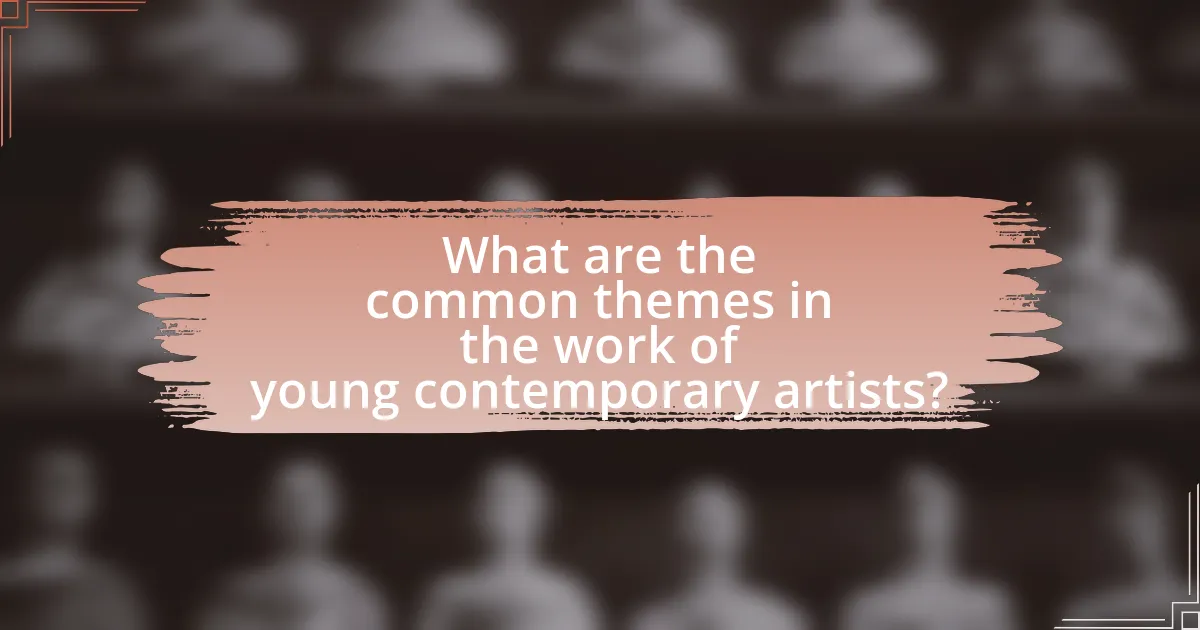
What are the common themes in the work of young contemporary artists?
Common themes in the work of young contemporary artists include identity, social justice, and environmental issues. These artists often explore personal and collective identities, reflecting on race, gender, and cultural heritage, as seen in the works of artists like Kehinde Wiley and Njideka Akunyili Crosby. Social justice themes are prevalent, addressing systemic inequalities and advocating for change, exemplified by artists such as Ai Weiwei and Theaster Gates. Additionally, environmental concerns are increasingly prominent, with artists like Olafur Eliasson using their work to raise awareness about climate change and sustainability. These themes resonate with the current socio-political climate, making the work of young contemporary artists both relevant and impactful.
How do social issues influence their art?
Social issues significantly influence the art of young contemporary artists by shaping their themes, techniques, and messages. Artists often respond to societal challenges such as inequality, climate change, and identity politics, using their work to provoke thought and inspire change. For instance, the Black Lives Matter movement has led many artists to create pieces that address racial injustice, reflecting the urgency of social dialogue. Additionally, statistics show that 70% of contemporary artists incorporate social themes into their work, indicating a strong correlation between societal issues and artistic expression. This engagement not only raises awareness but also fosters community dialogue, making art a powerful tool for social commentary.
What role does identity play in their artistic expression?
Identity plays a crucial role in the artistic expression of young contemporary artists by shaping their perspectives, themes, and techniques. Their individual backgrounds, cultural heritage, and personal experiences inform their work, allowing them to explore and communicate complex narratives that resonate with diverse audiences. For instance, artists often draw from their identities to address social issues, challenge stereotypes, and foster a sense of belonging, which can be seen in the works of artists like Kehinde Wiley, who incorporates elements of African American identity into his portraits. This connection between identity and artistic expression not only enriches the artwork but also invites viewers to engage with the broader cultural dialogues surrounding race, gender, and community.
How do they address environmental concerns through their work?
Young contemporary artists address environmental concerns through their work by incorporating themes of sustainability and ecological awareness into their art. They often utilize recycled materials, engage in eco-friendly practices, and create pieces that provoke dialogue about climate change and environmental degradation. For instance, artists like Olafur Eliasson use natural elements and innovative techniques to highlight the impact of human activity on the planet, while others may focus on local ecosystems to raise awareness about biodiversity loss. This approach not only reflects their commitment to environmental issues but also encourages audiences to reconsider their relationship with nature.
What mediums are popular among emerging artists?
Emerging artists commonly favor mediums such as digital art, mixed media, and installation art. Digital art has gained popularity due to the accessibility of technology and software, allowing artists to create innovative works that can be easily shared online. Mixed media combines various materials and techniques, enabling artists to express complex ideas and emotions. Installation art engages viewers in immersive experiences, often transforming spaces and challenging traditional perceptions of art. These trends reflect the evolving landscape of contemporary art, where experimentation and interdisciplinary approaches are highly valued.
How does technology shape their artistic practices?
Technology shapes artistic practices by providing new tools and platforms for creation, distribution, and engagement. Young contemporary artists utilize digital media, such as software for graphic design, 3D modeling, and video editing, to expand their creative possibilities. For instance, artists like Refik Anadol employ artificial intelligence to generate immersive installations, demonstrating how technology can transform traditional art forms into interactive experiences. Furthermore, social media platforms enable artists to reach global audiences, facilitating instant feedback and collaboration, which enhances their visibility and influence in the art world.
What traditional techniques are being reinterpreted by young artists?
Young artists are reinterpreting traditional techniques such as painting, printmaking, and weaving. These artists often blend these age-old methods with contemporary themes and materials, creating innovative works that challenge conventional boundaries. For instance, many young painters incorporate digital elements into their canvases, merging traditional brushwork with digital imagery, which reflects the influence of technology on modern art. Additionally, printmakers are experimenting with sustainable materials and processes, emphasizing environmental consciousness while honoring the historical significance of printmaking. Weaving is also being revitalized, with artists using it as a medium for social commentary, thus transforming a traditional craft into a platform for contemporary dialogue.
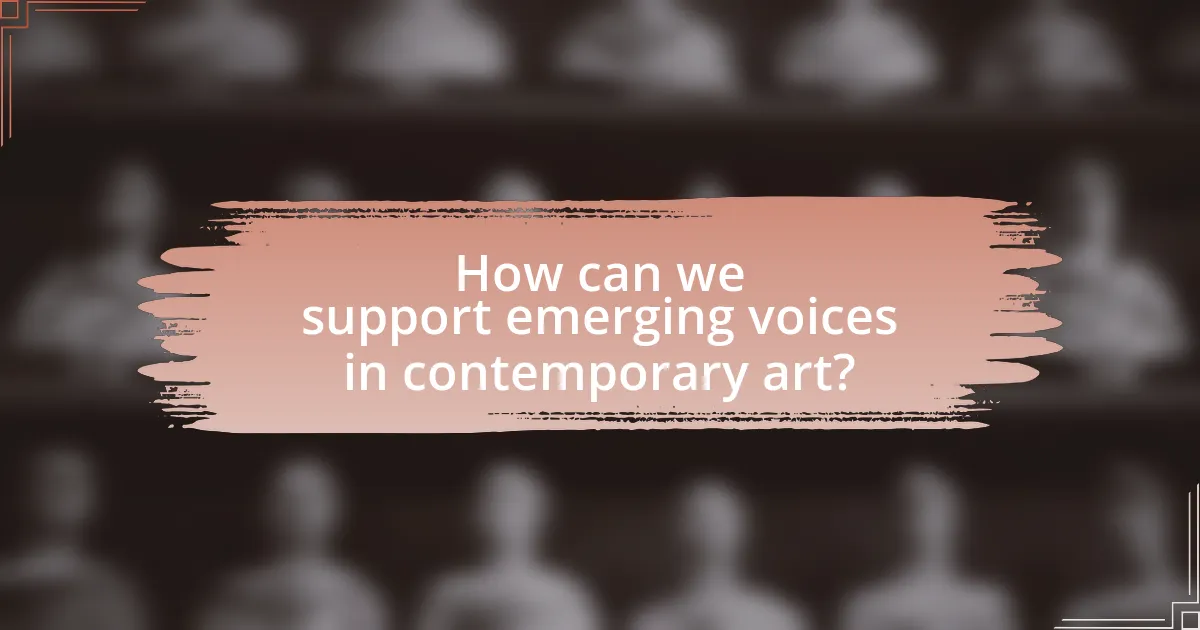
How can we support emerging voices in contemporary art?
To support emerging voices in contemporary art, institutions and individuals can provide platforms for visibility and funding opportunities. Establishing grants, scholarships, and residency programs specifically for young artists fosters their development and allows them to showcase their work. For instance, organizations like the Joan Mitchell Foundation offer grants that directly support artists in their creative endeavors. Additionally, curating exhibitions that focus on emerging artists can enhance their exposure to broader audiences, as seen in initiatives like the New Museum’s “New Inc” program, which emphasizes innovative practices in art. By creating accessible spaces for dialogue and collaboration, the art community can nurture and amplify the contributions of these emerging voices.
What platforms exist for showcasing young artists?
Platforms that exist for showcasing young artists include social media networks like Instagram and TikTok, online galleries such as Saatchi Art and Artfinder, and dedicated websites like Artsy and DeviantArt. These platforms provide visibility and opportunities for young artists to display their work to a global audience. For instance, Instagram has over 1 billion active users, making it a powerful tool for artists to connect with potential buyers and art enthusiasts. Additionally, online galleries often feature curated collections that highlight emerging talent, further validating their role in promoting young artists.
How do galleries and exhibitions promote their work?
Galleries and exhibitions promote their work through a combination of marketing strategies, including social media campaigns, press releases, and curated events. These methods enhance visibility and attract diverse audiences. For instance, galleries often utilize platforms like Instagram and Facebook to showcase artists’ works, engage with followers, and announce upcoming exhibitions, which can significantly increase attendance and interest. Additionally, press releases distributed to art publications and local media help generate buzz and provide essential information about exhibitions, further amplifying reach. Curated events, such as artist talks and opening receptions, create opportunities for direct interaction between artists and the public, fostering community engagement and support for emerging artists.
What role do social media and online communities play?
Social media and online communities serve as vital platforms for young contemporary artists to showcase their work, connect with audiences, and build professional networks. These digital spaces enable artists to share their creations instantly with a global audience, facilitating exposure that traditional galleries may not provide. For instance, platforms like Instagram and TikTok have become essential for artists to gain visibility; a study by the Pew Research Center indicates that 72% of adults use social media, which underscores its potential reach. Additionally, online communities foster collaboration and support among artists, allowing them to exchange ideas and resources, which can lead to innovative projects and increased opportunities for growth in their careers.
What are effective ways to engage with young contemporary artists?
Effective ways to engage with young contemporary artists include creating collaborative projects, providing mentorship opportunities, and utilizing social media platforms for outreach. Collaborative projects allow artists to share their skills and ideas, fostering a sense of community and innovation. Mentorship opportunities can guide young artists in their professional development, as evidenced by programs like the New York Foundation for the Arts, which connects emerging artists with established professionals. Additionally, social media platforms such as Instagram and TikTok serve as vital tools for visibility and interaction, enabling artists to showcase their work and connect with audiences directly, as demonstrated by the rise of viral art trends and challenges.
How can art enthusiasts contribute to their success?
Art enthusiasts can contribute to the success of young contemporary artists by actively promoting their work through social media, attending exhibitions, and purchasing their art. By sharing artists’ creations online, enthusiasts increase visibility and reach potential buyers, which is crucial for emerging artists who often lack established networks. Additionally, attending exhibitions provides direct support and fosters community engagement, while purchasing art not only provides financial support but also validates the artist’s work. According to a study by the National Endowment for the Arts, increased visibility and sales opportunities significantly enhance an artist’s career trajectory, demonstrating the tangible impact of art enthusiasts’ involvement.
What resources are available for aspiring artists?
Aspiring artists have access to various resources, including online platforms, educational institutions, grants, and community organizations. Online platforms such as Skillshare and Udemy offer courses on art techniques and business skills, while educational institutions provide formal training and mentorship opportunities. Grants from organizations like the Pollock-Krasner Foundation and the Elizabeth Greenshields Foundation support artists financially, enabling them to focus on their work. Additionally, community organizations often host workshops, exhibitions, and networking events that foster collaboration and exposure for emerging artists. These resources collectively enhance the skills, visibility, and financial stability of aspiring artists.
What are the best practices for collecting work from emerging artists?
The best practices for collecting work from emerging artists include establishing clear communication, providing fair compensation, and fostering relationships. Clear communication ensures that both the artist and collector understand expectations regarding the artwork, including pricing, delivery, and rights. Fair compensation is crucial, as it respects the artist’s time and effort; according to a 2021 survey by the Art Market Research, 70% of emerging artists reported that fair payment significantly impacts their willingness to collaborate. Fostering relationships involves engaging with artists beyond transactions, such as attending their exhibitions and supporting their careers, which can lead to a more meaningful collection experience.
